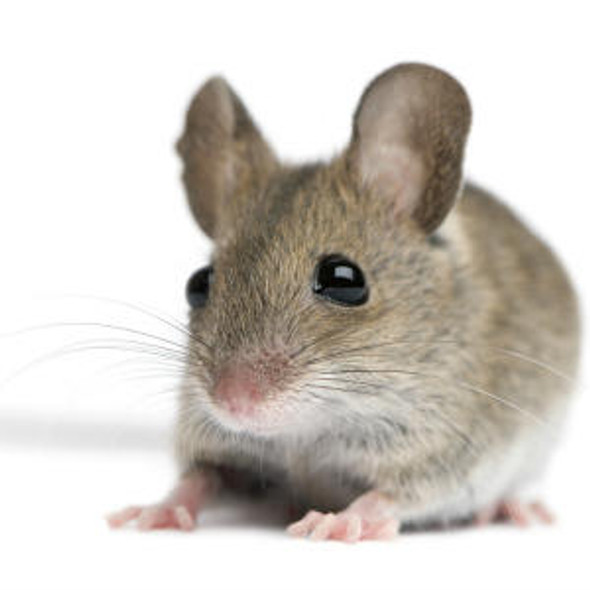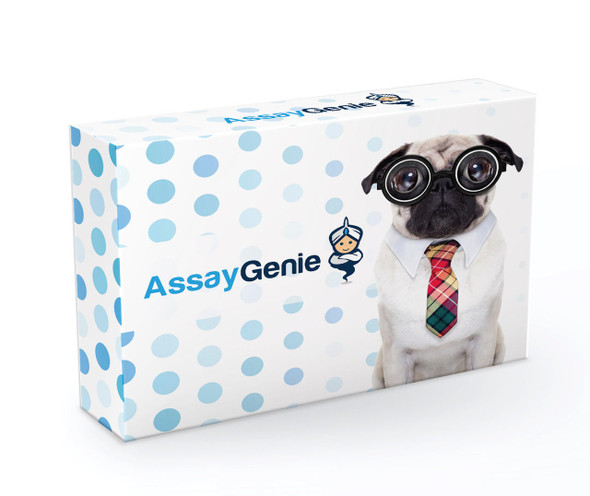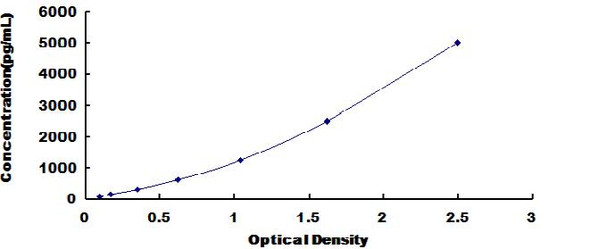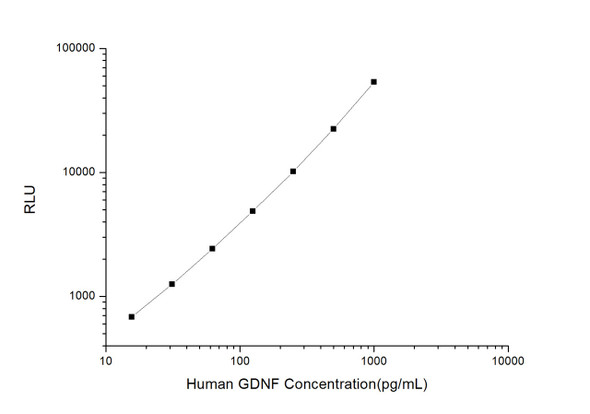Mouse Cell Signalling ELISA Kits 2
Mouse GDNF (Glial Cell Line Derived Neurotrophic Factor) CLIA Kit (MOES00289)
- SKU:
- MOES00289
- Product Type:
- ELISA Kit
- ELISA Type:
- CLIA Kit
- Size:
- 96 Assays
- Sensitivity:
- 9.38pg/mL
- Range:
- 15.63-1000pg/mL
- ELISA Type:
- Sandwich
- Synonyms:
- ATF, ATF1, ATF2, HFB1-GDNF, HSCR3
- Reactivity:
- Mouse
- Sample Type:
- Serum, plasma and other biological fluids
Description
| Assay type: | Sandwich |
| Format: | 96T |
| Assay time: | 4.5h |
| Reactivity: | Mouse |
| Detection method: | Chemiluminescence |
| Detection range: | 15.63-1000 pg/mL |
| Sensitivity: | 9.38 pg/mL |
| Sample volume: | 100µL |
| Sample type: | Serum, plasma and other biological fluids |
| Repeatability: | CV < 15% |
| Specificity: | This kit recognizes Mouse GDNF in samples. No significant cross-reactivity or interference between Mouse GDNF and analogues was observed. |
This kit uses Sandwich-CLIA as the method. The micro CLIA plate provided in this kit has been pre-coated with an antibody specific to Mouse GDNF. Standards or samples are added to the appropriate micro CLIA plate wells and combined with the specific antibody. Then a biotinylated detection antibody specific for Mouse GDNF and Avidin-Horseradish Peroxidase (HRP) conjugate are added to each micro plate well successively and incubated. Free components are washed away. The substrate solution is added to each well. Only those wells that contain Mouse GDNF, biotinylated detection antibody and Avidin-HRP conjugate will appear fluorescence. The Relative light unit (RLU) value is measured spectrophotometrically by the Chemiluminescence immunoassay analyzer. The RLU value is positively associated with the concentration of Mouse GDNF. The concentration of Mouse GDNF in the samples can be calculated by comparing the RLU of the samples to the standard curve.
| UniProt Protein Function: | GDNF: Neurotrophic factor that enhances survival and morphological differentiation of dopaminergic neurons and increases their high-affinity dopamine uptake. Defects in GDNF may be a cause of Hirschsprung disease type 3 (HSCR3). In association with mutations of RET gene, defects in GDNF may be involved in Hirschsprung disease. This genetic disorder of neural crest development is characterized by the absence of intramural ganglion cells in the hindgut, often resulting in intestinal obstruction. Defects in GDNF are a cause of congenital central hypoventilation syndrome (CCHS); also known as congenital failure of autonomic control or Ondine curse. CCHS is a rare disorder characterized by abnormal control of respiration in the absence of neuromuscular or lung disease, or an identifiable brain stem lesion. A deficiency in autonomic control of respiration results in inadequate or negligible ventilatory and arousal responses to hypercapnia and hypoxemia. Belongs to the TGF-beta family. GDNF subfamily. 5 isoforms of the human protein are produced by alternative splicing. |
| UniProt Protein Details: | Protein type:Secreted, signal peptide; Secreted Cellular Component: extracellular space; extracellular region; receptor complex Molecular Function:glial cell line-derived neurotrophic factor receptor binding; protein homodimerization activity; growth factor activity; transforming growth factor beta receptor binding Biological Process: peristalsis; enteric nervous system development; neuron differentiation; sympathetic nervous system development; ureteric bud development; transforming growth factor beta receptor signaling pathway; induction of an organ; positive regulation of cell proliferation; response to wounding; postganglionic parasympathetic nervous system development; negative regulation of neuron apoptosis; postsynaptic membrane organization; neural crest cell migration; neurite development; nervous system development; mRNA stabilization; positive regulation of monooxygenase activity; regulation of dopamine uptake; peripheral nervous system development; cell proliferation; regulation of gene expression; ureteric bud branching; positive regulation of transcription from RNA polymerase II promoter; positive regulation of cell differentiation; metanephros development; transmembrane receptor protein tyrosine kinase signaling pathway |
| UniProt Code: | P48540 |
| NCBI GenInfo Identifier: | 1346126 |
| NCBI Gene ID: | 14573 |
| NCBI Accession: | P48540. 1 |
| UniProt Secondary Accession: | P48540,O09058, P70446, P97919, P97920, Q6LEL9, |
| UniProt Related Accession: | P48540 |
| Molecular Weight: | 26,606 Da |
| NCBI Full Name: | Glial cell line-derived neurotrophic factor |
| NCBI Synonym Full Names: | glial cell line derived neurotrophic factor |
| NCBI Official Symbol: | Gdnf |
| NCBI Official Synonym Symbols: | AI385739 |
| NCBI Protein Information: | glial cell line-derived neurotrophic factor; ATF; mGDNF; astrocyte-derived trophic factor |
| UniProt Protein Name: | Glial cell line-derived neurotrophic factor |
| UniProt Synonym Protein Names: | Astrocyte-derived trophic factor; ATF |
| Protein Family: | GDNF family receptor |
| UniProt Gene Name: | Gdnf |
| UniProt Entry Name: | GDNF_MOUSE |
As the RLU values of the standard curve may vary according to the conditions of the actual assay performance (e. g. operator, pipetting technique, washing technique or temperature effects), the operator should establish a standard curve for each test. Typical standard curve and data is provided below for reference only.
| Concentration (pg/mL) | RLU | Average | Corrected |
| 1000 | 48890 58460 | 53675 | 53650 |
| 500 | 20977 24001 | 22489 | 22464 |
| 250 | 10860 9562 | 10211 | 10186 |
| 125 | 4499 5303 | 4901 | 4876 |
| 62.5 | 2462 2444 | 2453 | 2428 |
| 31.25 | 1300 1262 | 1281 | 1256 |
| 15.63 | 693 723 | 708 | 683 |
| 0 | 24 26 | 25 | -- |
Precision
Intra-assay Precision (Precision within an assay): 3 samples with low, mid range and high level Mouse GDNF were tested 20 times on one plate, respectively.
Inter-assay Precision (Precision between assays): 3 samples with low, mid range and high level Mouse GDNF were tested on 3 different plates, 20 replicates in each plate.
| Intra-assay Precision | Inter-assay Precision | |||||
| Sample | 1 | 2 | 3 | 1 | 2 | 3 |
| n | 20 | 20 | 20 | 20 | 20 | 20 |
| Mean (pg/mL) | 55.10 | 114.36 | 448.12 | 58.01 | 115.89 | 468.58 |
| Standard deviation | 4.64 | 10.22 | 48.98 | 4.77 | 9.95 | 37.44 |
| C V (%) | 8.42 | 8.94 | 10.93 | 8.22 | 8.59 | 7.99 |
Recovery
The recovery of Mouse GDNF spiked at three different levels in samples throughout the range of the assay was evaluated in various matrices.
| Sample Type | Range (%) | Average Recovery (%) |
| Serum (n=5) | 96-110 | 103 |
| EDTA plasma (n=5) | 85-100 | 92 |
| Cell culture media (n=5) | 93-105 | 100 |
Linearity
Samples were spiked with high concentrations of Mouse GDNF and diluted with Reference Standard & Sample Diluent to produce samples with values within the range of the assay.
| Serum (n=5) | EDTA plasma (n=5) | Cell culture media (n=5) | ||
| 1:2 | Range (%) | 84-98 | 102-119 | 85-96 |
| Average (%) | 90 | 109 | 91 | |
| 1:4 | Range (%) | 87-100 | 94-109 | 102-115 |
| Average (%) | 94 | 99 | 109 | |
| 1:8 | Range (%) | 94-106 | 93-106 | 94-107 |
| Average (%) | 100 | 99 | 99 | |
| 1:16 | Range (%) | 89-101 | 97-112 | 95-108 |
| Average (%) | 95 | 103 | 101 |
An unopened kit can be stored at 4°C for 1 month. If the kit is not used within 1 month, store the items separately according to the following conditions once the kit is received.
| Item | Specifications | Storage |
| Micro CLIA Plate(Dismountable) | 8 wells ×12 strips | -20°C, 6 months |
| Reference Standard | 2 vials | |
| Concentrated Biotinylated Detection Ab (100×) | 1 vial, 120 µL | |
| Concentrated HRP Conjugate (100×) | 1 vial, 120 µL | -20°C(shading light), 6 months |
| Reference Standard & Sample Diluent | 1 vial, 20 mL | 4°C, 6 months |
| Biotinylated Detection Ab Diluent | 1 vial, 14 mL | |
| HRP Conjugate Diluent | 1 vial, 14 mL | |
| Concentrated Wash Buffer (25×) | 1 vial, 30 mL | |
| Substrate Reagent A | 1 vial, 5 mL | 4°C (shading light) |
| Substrate Reagent B | 1 vial, 5 mL | 4°C (shading light) |
| Plate Sealer | 5 pieces | |
| Product Description | 1 copy | |
| Certificate of Analysis | 1 copy |
- Set standard, test sample and control (zero) wells on the pre-coated plate and record theirpositions. It is recommended to measure each standard and sample in duplicate. Note: addall solutions to the bottom of the plate wells while avoiding contact with the well walls. Ensuresolutions do not foam when adding to the wells.
- Aliquot 100µl of standard solutions into the standard wells.
- Add 100µl of Sample / Standard dilution buffer into the control (zero) well.
- Add 100µl of properly diluted sample (serum, plasma, tissue homogenates and otherbiological fluids. ) into test sample wells.
- Cover the plate with the sealer provided in the kit and incubate for 90 min at 37°C.
- Aspirate the liquid from each well, do not wash. Immediately add 100µL of BiotinylatedDetection Ab working solution to each well. Cover the plate with a plate seal and gently mix. Incubate for 1 hour at 37°C.
- Aspirate or decant the solution from the plate and add 350µL of wash buffer to each welland incubate for 1-2 minutes at room temperature. Aspirate the solution from each well andclap the plate on absorbent filter paper to dry. Repeat this process 3 times. Note: a microplatewasher can be used in this step and other wash steps.
- Add 100µL of HRP Conjugate working solution to each well. Cover with a plate seal andincubate for 30 min at 37°C.
- Aspirate or decant the solution from each well. Repeat the wash process for five times asconducted in step 7.
- Add 100µL of Substrate mixture solution to each well. Cover with a new plate seal andincubate for no more than 5 min at 37°C. Protect the plate from light.
- Determine the RLU value of each well immediately.






